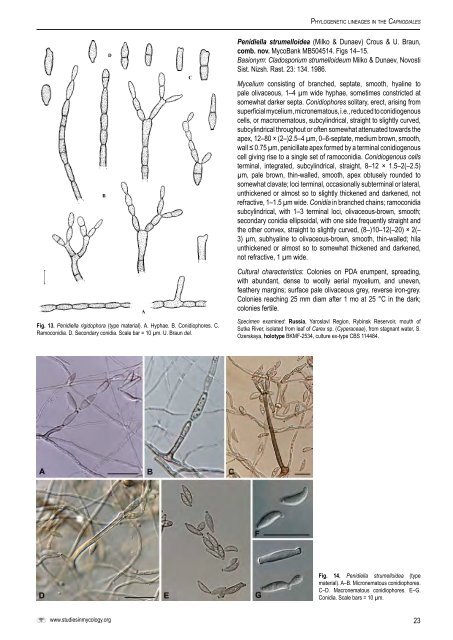The genus Cladosporium and similar dematiaceous ... - CBS - KNAW
The genus Cladosporium and similar dematiaceous ... - CBS - KNAW
The genus Cladosporium and similar dematiaceous ... - CBS - KNAW
You also want an ePaper? Increase the reach of your titles
YUMPU automatically turns print PDFs into web optimized ePapers that Google loves.
Phylogenetic lineages in the Capnodiales<br />
Penidiella strumelloidea (Milko & Dunaev) Crous & U. Braun,<br />
comb. nov. MycoBank MB504514. Figs 14–15.<br />
Basionym: <strong>Cladosporium</strong> strumelloideum Milko & Dunaev, Novosti<br />
Sist. Nizsh. Rast. 23: 134. 1986.<br />
Mycelium consisting of branched, septate, smooth, hyaline to<br />
pale olivaceous, 1–4 µm wide hyphae, sometimes constricted at<br />
somewhat darker septa. Conidiophores solitary, erect, arising from<br />
superficial mycelium, micronematous, i.e., reduced to conidiogenous<br />
cells, or macronematous, subcylindrical, straight to slightly curved,<br />
subcylindrical throughout or often somewhat attenuated towards the<br />
apex, 12–80 × (2–)2.5–4 µm, 0–6-septate, medium brown, smooth,<br />
wall ≤ 0.75 µm, penicillate apex formed by a terminal conidiogenous<br />
cell giving rise to a single set of ramoconidia. Conidiogenous cells<br />
terminal, integrated, subcylindrical, straight, 8–12 × 1.5–2(–2.5)<br />
µm, pale brown, thin-walled, smooth, apex obtusely rounded to<br />
somewhat clavate; loci terminal, occasionally subterminal or lateral,<br />
unthickened or almost so to slightly thickened <strong>and</strong> darkened, not<br />
refractive, 1–1.5 µm wide. Conidia in branched chains; ramoconidia<br />
subcylindrical, with 1–3 terminal loci, olivaceous-brown, smooth;<br />
secondary conidia ellipsoidal, with one side frequently straight <strong>and</strong><br />
the other convex, straight to slightly curved, (8–)10–12(–20) × 2(–<br />
3) µm, subhyaline to olivaceous-brown, smooth, thin-walled; hila<br />
unthickened or almost so to somewhat thickened <strong>and</strong> darkened,<br />
not refractive, 1 µm wide.<br />
Cultural characteristics: Colonies on PDA erumpent, spreading,<br />
with abundant, dense to woolly aerial mycelium, <strong>and</strong> uneven,<br />
feathery margins; surface pale olivaceous grey, reverse iron-grey.<br />
Colonies reaching 25 mm diam after 1 mo at 25 °C in the dark;<br />
colonies fertile.<br />
Fig. 13. Penidiella rigidophora (type material). A. Hyphae. B. Conidiophores. C.<br />
Ramoconidia. D. Secondary conidia. Scale bar = 10 µm. U. Braun del.<br />
Specimen examined: Russia, Yaroslavl Region, Rybinsk Reservoir, mouth of<br />
Sutka River, isolated from leaf of Carex sp. (Cyperaceae), from stagnant water, S.<br />
Ozerskaya, holotype BKMF-2534, culture ex-type <strong>CBS</strong> 114484.<br />
Fig. 14. Penidiella strumelloidea (type<br />
material). A–B. Micronematous conidiophores.<br />
C–D. Macronematous conidiophores. E–G.<br />
Conidia. Scale bars = 10 µm.<br />
www.studiesinmycology.org<br />
23

















